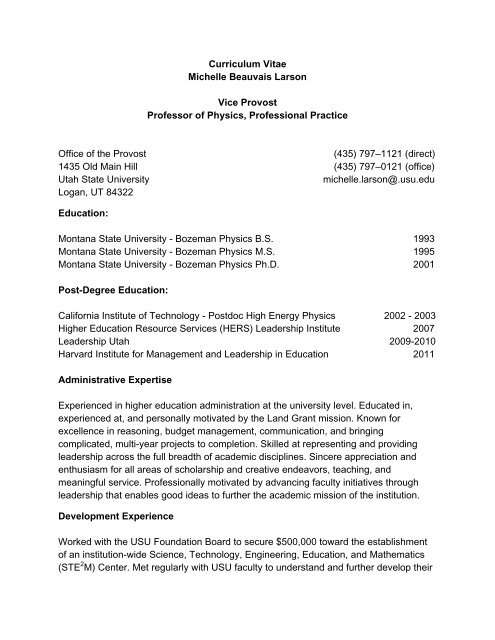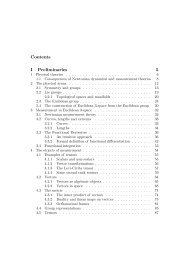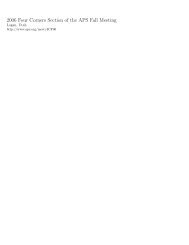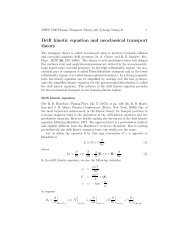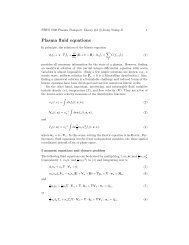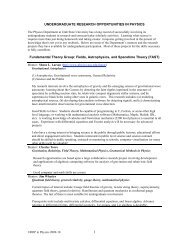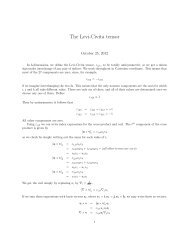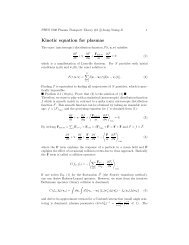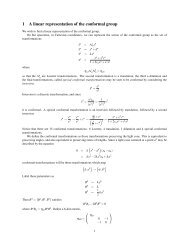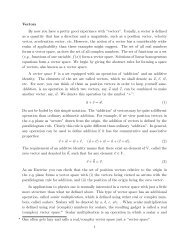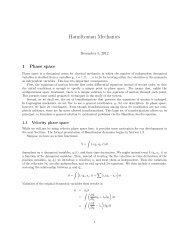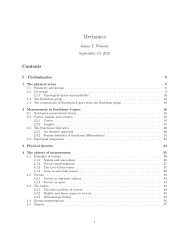Curriculum Vitae Michelle Beauvais Larson Vice Provost Professor ...
Curriculum Vitae Michelle Beauvais Larson Vice Provost Professor ...
Curriculum Vitae Michelle Beauvais Larson Vice Provost Professor ...
You also want an ePaper? Increase the reach of your titles
YUMPU automatically turns print PDFs into web optimized ePapers that Google loves.
<strong>Curriculum</strong> <strong>Vitae</strong><br />
<strong>Michelle</strong> <strong>Beauvais</strong> <strong>Larson</strong><br />
<strong>Vice</strong> <strong>Provost</strong><br />
<strong>Professor</strong> of Physics, Professional Practice<br />
Office of the <strong>Provost</strong><br />
(435) 797–1121 (direct)<br />
1435 Old Main Hill (435) 797–0121 (office)<br />
Utah State University<br />
michelle.larson@.usu.edu<br />
Logan, UT 84322<br />
Education:<br />
Montana State University - Bozeman Physics B.S. 1993<br />
Montana State University - Bozeman Physics M.S. 1995<br />
Montana State University - Bozeman Physics Ph.D. 2001<br />
Post-Degree Education:<br />
California Institute of Technology - Postdoc High Energy Physics 2002 - 2003<br />
Higher Education Resource Services (HERS) Leadership Institute 2007<br />
Leadership Utah 2009-2010<br />
Harvard Institute for Management and Leadership in Education 2011<br />
Administrative Expertise<br />
Experienced in higher education administration at the university level. Educated in,<br />
experienced at, and personally motivated by the Land Grant mission. Known for<br />
excellence in reasoning, budget management, communication, and bringing<br />
complicated, multi-year projects to completion. Skilled at representing and providing<br />
leadership across the full breadth of academic disciplines. Sincere appreciation and<br />
enthusiasm for all areas of scholarship and creative endeavors, teaching, and<br />
meaningful service. Professionally motivated by advancing faculty initiatives through<br />
leadership that enables good ideas to further the academic mission of the institution.<br />
Development Experience<br />
Worked with the USU Foundation Board to secure $500,000 toward the establishment<br />
of an institution-wide Science, Technology, Engineering, Education, and Mathematics<br />
(STE 2 M) Center. Met regularly with USU faculty to understand and further develop their
vision, served as the lead communicator of the Center’s vision to the USU Foundation<br />
Board, and met with individual donors to secure the funds necessary to launch the<br />
STE 2 M Center.<br />
Externally-Funded Grant Experience<br />
First-hand experience with the demands of proposal preparation. Solid understanding of<br />
the support infrastructure necessary to help faculty succeed. Comfortable and<br />
experienced at mentoring and supporting faculty in the pursuit of obtaining external<br />
grant resources. Employed exclusively for five years (2001 - 2006) on grant dollars.<br />
Understanding of what is necessary to prepare and submit a competitive grant proposal.<br />
Externally-funded grant experience ranges from being a federally-funded PI to being a<br />
member of the administrative team at a multi-million dollar National Science Foundation<br />
(NSF) research center. Deputy director of a $5 Million NSF Physics Frontier Center at<br />
The Pennsylvania State University, responsible for oversight of review team site visits<br />
and co-investigator and proposal coordinator on the $10 Million renewal proposal. At<br />
Caltech, funded by the NSF as project coordinator for a multisite scintillator detector<br />
cosmic ray observatory. Funded by the National Aeronautics and Space Administration<br />
(NASA) at the University of California, Berkeley as lead developer and author of the<br />
Education and Public Outreach component on several SMEX and MIDEX mission<br />
teams.<br />
Science Outreach Experience<br />
Twenty two years experience in science outreach ranging from: $1 - $2 million<br />
education outreach program development for NASA missions, including the<br />
development of classroom activities resulting in peer-reviewed publications; to project<br />
coordinator for a distributed array of scientific cosmic ray detectors at Los Angeles area<br />
high schools; to director for education and public outreach at an NSF Physics Frontier<br />
Center. Creator and co-chair of Science Unwrapped at Utah State University, a monthly<br />
presentation and associated experience stations that unwrap the process of science for<br />
a lay audience. Science Unwrapped has reach over 8500 attendees in its first three<br />
years. Regular presenter of public lecturers on astronomy and astrophysics to<br />
audiences including: youth groups and senior centers; amateur astronomy clubs and<br />
regional star parties; museums; teacher development workshops; and national<br />
monuments and parks.<br />
M. B. <strong>Larson</strong> <strong>Curriculum</strong> <strong>Vitae</strong> 2
Administrative Positions<br />
<strong>Vice</strong> <strong>Provost</strong> (2011 - present), Assistant <strong>Provost</strong> (2006-2011)<br />
Utah State University<br />
• A broad portfolio that includes: primary responsibility for strategic projects that<br />
address the dynamic priorities and needs of a comprehensive research<br />
university; overseeing the budget for the Office of the Executive <strong>Vice</strong> President<br />
and <strong>Provost</strong>; and serving as Utah State University’s representative to the Chief<br />
Academic Officers council in the Utah System of Higher Education.<br />
• Direct supervisor to five staff, including the <strong>Provost</strong>’s budget officer. Operational<br />
and fiscal supervisor to four unit directors: Affirmative Action/Equal Opportunity;<br />
Analysis, Assessment & Accreditation; Faculty Assistance Center for Teaching;<br />
and Honors Program.<br />
• Creator and co-chair of Science Unwrapped a monthly presentation and<br />
associated experience stations that unwrap the process of science for a lay<br />
audience. The program is hosted by USU’s College of Science, has featured<br />
research from all academic colleges, and consistently attracts between 200 - 400<br />
people to every event, reaching more than 8000 in the first three years.<br />
• Provided academic leadership during the merger of a two-year community and<br />
technical college with Utah State University. Worked to place all faculty into an<br />
appropriate academic department and oversaw the process of incorporating and<br />
synchronizing course offerings and academic policies. In less than one year after<br />
the merger date all faculty had tenure status and a signed role statement within a<br />
USU academic department, and students from both institutions were able to<br />
register under a single academic catalog.<br />
• Served as the academic program lead during the merger of the Swaner<br />
EcoCenter and Preserve, the largest philanthropic gift in USU’s history. Led four<br />
separate working groups to develop multi-year programming plans focused on 1)<br />
Community, 2) Youth, 3) For-Credit Courses and 4) the Land.<br />
• Responsible for bringing all university academic business before the USU Board<br />
of Trustees and the Utah Board of Regents for approval. A 100% success rate in<br />
program approval in the four years since assuming this responsibility, including<br />
successfully navigating through the process two proposals that had been<br />
previously denied, and several challenging proposals that were solid<br />
academically, but had political opposition.<br />
M. B. <strong>Larson</strong> <strong>Curriculum</strong> <strong>Vitae</strong> 3
• Responsible for designing and implementing a five-year plan to increase the<br />
operating budgets of all academic departments at USU by $1.5 Million.<br />
Conducted a fiscal analysis to determine the metric by which operating budget<br />
increases would be determined and distributed.<br />
• Leader of Extra Service Compensation reform on campus. Six years experience<br />
developing and implementing a step-by-step campus-wide plan to bring extra<br />
service into compliance with policy.<br />
• Chair of the University Space Management committee. Responsible for<br />
negotiating resolution in multi-college space conflicts. Responsible for organizing<br />
complex, multi-unit building relocations.<br />
• Chair of the University Course Fee Review committee. Responsible for<br />
conducting a detailed analysis and review of university-wide course fee revenue<br />
and student course fee burden by major to inform the course fee review process.<br />
• Served as the campus lead for the National Collegiate Athletic Association<br />
(NCAA) Ten-Year Recertification of Utah State University. Responsibilities in<br />
addition to lead coordinator included chief report writer, Academic Integrity<br />
Committee member and Steering Committee member. Currently serve as the<br />
Utah State University NCAA Athletics Certification Liaison.<br />
Deputy Director, Center for Gravitational Wave Physics (2004 - 2006)<br />
The Pennsylvania State University<br />
• Responsible for primary administration tasks of the Center for Gravitational Wave<br />
Physics (CGWP) including budget management, coordinating annual reports and<br />
site visits, scientific workshop planning and proposal writing.<br />
• Fostered research partnerships between national and international astrophysics<br />
and gravitational wave physics communities, and built outreach partnerships<br />
between the CGWP and other national centers, labs and informal education<br />
venues. Established the first national network of Physics Frontier Center (PFC)<br />
outreach coordinators resulting in a united PFC presence at national conferences<br />
and increased visibility of PFC efforts within the NSF.<br />
• Responsible for communicating the frontier research science performed by the<br />
Center to fellow scientists and broad audiences. Author of ten research<br />
M. B. <strong>Larson</strong> <strong>Curriculum</strong> <strong>Vitae</strong> 4
informational nuggets, and editor of The Gravitational Lens, a newsletter<br />
summarizing recent, published results in the field of gravity.<br />
• Created and directed research science outreach efforts and public outreach<br />
programs to increase the general understanding of gravitational physics and<br />
awareness of recent progress in gravitational wave research among broad<br />
audiences, including scientists of all disciplines. Successfully facilitated research<br />
efforts between students and faculty in distant locations as far away from<br />
Pennsylvania as Washington State.<br />
Deputy Director, Montana Space Grant Consortium & EPSCoR (2003 - 2004)<br />
Montana State University<br />
• Primary administrator of research initiation grants, education enhancement<br />
grants, undergraduate research grants and student fellowships.<br />
• Coordinated and led 21 state consortium affiliates to strengthen research and<br />
education in aeronautics and space science in the state of Montana.<br />
• Assisted research faculty in identifying national partnerships and stimulating<br />
competitive research throughout the state.<br />
• Coordinated and led students in Earth-orbiting satellite, high altitude balloon and<br />
space science outreach programs.<br />
CHICOS Project Coordinator, Kellogg Radiation Laboratory (2002-2003)<br />
California Institute of Technology<br />
• Identified and secured detector sites and built a ground-based cosmic ray<br />
detector array deployed on school rooftops in Los Angeles.<br />
• Built partnerships with school district administrators, and served as lead project<br />
liaison to teachers and students.<br />
• Commissioned and calibrated detector equipment, and facilitated the research<br />
efforts of students, postdocs and fellow scientists in the collaboration.<br />
M. B. <strong>Larson</strong> <strong>Curriculum</strong> <strong>Vitae</strong> 5
Scientific Positions<br />
As a scientist who is passionate about research-infused public outreach I routinely give<br />
public lectures and present at teacher development workshops. I have developed fifteen<br />
science-based hands-on activities, many of which received national recognition by the<br />
National Science Teachers Association and/or have been published in peer-reviewed<br />
journals. Selected accomplishments and responsibilities are discussed below.<br />
<strong>Professor</strong> of Physics, Professional Practice (2012 - Present)<br />
Associate <strong>Professor</strong> of Physics, Adjunct (2006 – 2011)<br />
Utah State University<br />
• Provide leadership for campus-wide STEM and STEM education efforts.<br />
• PI of a multi-institutional, multi-disciplinary team working on a $2.5 Million<br />
university-wide NSF proposal to increase the number of graduates in STEM<br />
disciplines. (To be submitted in Fall 2012).<br />
• Regularly work with faculty to leverage broader impact funding in traditional<br />
research proposals through department, college or campus programs.<br />
• Mentor to students majoring in physics, or considering physics as a major,<br />
particularly students from underrepresented groups.<br />
Research Associate, Department of Physics (2004-2006)<br />
The Pennsylvania State University<br />
• Served as the Editor-in-Chief of the Gravitational Lens - An international<br />
newsletter highlighting recent work relevant to gravitational physics. Each issue<br />
contained summaries (written at a level for scientists in any discipline) that<br />
highlighted gravity-related preprints of broad interest.<br />
• Developed seven StarDate Radio Episodes, “Gravity (6.27.05); Gravitational<br />
Waves I (6.28.05); Gravitational Waves II (6.29.05); Speed of Gravity (7.01.05);<br />
Twirling Timebomb (4.26.06); Rippling Encounters (4.27.06); Star Probes<br />
(4.28.06), in collaboration with Univ. of Texas McDonald Observatory.<br />
• Script developer for the WPSX-TV public television show, “What’s in the News –<br />
Grasping for Gravity”, April 30, 2004.<br />
M. B. <strong>Larson</strong> <strong>Curriculum</strong> <strong>Vitae</strong> 6
Postdoc (2002), Staff Scientist (2003) Kellogg Radiation Laboratory<br />
California Institute of Technology<br />
• Led a scientific team of undergraduate and graduate students, postdocs and<br />
laboratory technicians to build, deploy, and operate a distributed array of cosmic<br />
ray scintillator detectors. Efforts resulted in peer reviewed publications.<br />
• Designed and coordinated a summer research program for high school students<br />
and teachers who worked side-by-side with our group to build the equipment<br />
used in the experiment.<br />
Public Outreach Scientist, Space Sciences Laboratory (2001-2002)<br />
University of California – Berkeley<br />
• Script developer and on-screen participant in the Emmy-winning NASA Connect<br />
television show, “Having a Solar Blast”, March 2002<br />
• Developed the outreach proposal concept, and coordinated the installation of an<br />
array of all-sky cameras and magnetometers at schools across the northern<br />
United States as part of the NASA THEMIS mission. Efforts resulted in a peerreviewed<br />
publication.<br />
Graduate Research Fellow, Department of Physics (1995-2001)<br />
Montana State University<br />
• Founder and co-director of the Space Public Outreach Team, a team of trained<br />
undergraduate science majors who travel to schools across Montana to give<br />
presentations on active NASA missions and space topics of current interest. The<br />
program is still in operation after 16 years.<br />
• Lead website and classroom activity developer for the Yohkoh Public Outreach<br />
Project, one of NASA’s earliest forays into bringing scientific data to the public<br />
through the internet.<br />
• Co-Director of Peaks and Potentials, a summer, residential science camp for<br />
Montana students in grades 6-9.<br />
M. B. <strong>Larson</strong> <strong>Curriculum</strong> <strong>Vitae</strong> 7
Refereed Publications<br />
1. L.M. Peticolas, N. Craig, S.F. Odenwald, A. Walker, C.T. Russell, V. Angelopoulos,<br />
C. Willard, M.B. <strong>Larson</strong>, W.A. Hiscock, J.M. Stoke, M.B. Moldwin, The Time History of<br />
Events and Macroscale Interactions during Substorms (THEMIS) Education and<br />
Outreach (E/PO) Program, Space Science Review, 141, 557 (2008)<br />
2. L.J. Rubbo, S.L. <strong>Larson</strong>, M.B. <strong>Larson</strong>, D.R. Ingram, Hands-on Gravitational Wave<br />
Astronomy: Extracting astrophysical information from simulated signals, The American<br />
Journal of Physics, 75, 597 (2006).<br />
3. M.B. <strong>Larson</strong>, L.J. Rubbo, K.D. Zaleski, S.L. <strong>Larson</strong>, Science Icebreaker Activities: An<br />
Example from Gravitational Wave Astronomy, The Physics Teacher 44, 416 (2006).<br />
4. L.J. Rubbo, S.L. <strong>Larson</strong>, M.B. <strong>Larson</strong>, K.D. Zaleski Gravitational Waves: New<br />
Observatories for New Astronomy, The Physics Teacher, 44, 420 (2006).<br />
5. B.E. Carlson, E. Brobeck, C.J. Jillings, M.B. <strong>Larson</strong>, T.W. Lynn, R.D. McKeown, J.E.<br />
Hill, B.J. Falkowski, R. Seki, J. Sepikas, G.B. Yodh, Search for Correlated High Energy<br />
Cosmic Ray Events with CHICOS, Journal of Physics G: Nuclear Particle Physics 31,<br />
409 (2005).<br />
6. M.B. <strong>Larson</strong>, Universe Interactive: Static displays with active components, The<br />
Physics Teacher 43, 19 (2005).<br />
7. M.B. <strong>Larson</strong>, Constructing a Portable Sundial in Insights Into the Universe: Effective<br />
Ways to Teach Astronomy, American Association of Physics Teachers (2003), Eds. T.F.<br />
Slater, M. Zeilik.<br />
8. R. D. McKeown, J. Gao, M. B. <strong>Larson</strong>, R. Seki, A.Shoup, G. B. Yodh, California High<br />
School Cosmic Ray Observatory (CHICOS), SPIE: Astronomical Telescopes and<br />
Instrumentation Proceedings, (2002).<br />
9. M.B. <strong>Larson</strong> et al., The Yohkoh Public Outreach Project in Multiwavelength<br />
Observations of Coronal Structure and Dynamics, COSPAR Colloquia Series 13,<br />
Elsevier Science (2002), Eds. P.C.H.Martens, D. Cauffman.<br />
10. N. Craig, M.B. <strong>Larson</strong>, Our Sun - The Star of Classroom Activities and Public<br />
Outreach Events in Multiwavelength Observations of Coronal Structure and Dynamics,<br />
COSPAR Colloquia Series 13, Elsevier Science (2002), Eds. P.C.H. Martens, D.<br />
Cauffman.<br />
11. M.B. <strong>Larson</strong>, B. Link, Simulations of Glitches in Isolated Pulsars, MNRAS 333, 613<br />
(2002).<br />
M. B. <strong>Larson</strong> <strong>Curriculum</strong> <strong>Vitae</strong> 8
12. M.B. <strong>Larson</strong>, B. Link, Superfluid Friction and Late-time Thermal Evolution of Neutron<br />
Stars, Astrophysical Journal 521, 271 (1999).<br />
13. M.B. <strong>Larson</strong>, Constructing a Portable Sundial, The Physics Teacher 37:2, 113<br />
(1999).<br />
14. T.F. Slater, M.B. <strong>Larson</strong>, D.E. McKenzie, Bringing Physics of the Sun to the Public,<br />
Technological Horizons in Education Journal, 26:3, 74 (1998).<br />
Additional Publications:<br />
1. D. Ingram, M.B. <strong>Larson</strong>, F. Raab, J. Thacker, S. Whitcomb, Educational Support<br />
Materials for Einstein's Messengers , White paper submitted to the NSF (2006).<br />
2. The Gravitational Lens: (Editor-in-Chief, Lead Writer) - An e-newsletter highlighting<br />
recent work relevant to gravitational physics. Each issue contained summaries (written<br />
at a level for scientists in any field) that highlight gravity-related research preprints of<br />
broad interest (2005-2006).<br />
3. R. D. McKeown, J. Gao, M. B. <strong>Larson</strong>, C. Zheng, R. Seki, A. Shoup, G.B. Yodh, C.<br />
Jillings, K. Ganezer, J. Hill, W.E. Kieg, J. Sepikas, CHICOS: Status and Prospects, 28th<br />
International Cosmic Ray Conference Proceedings, (2003).<br />
4. R. D. McKeown, J. Gao, M. B. <strong>Larson</strong>, A. Shoup, G.B. Yodh, CHICOS Detector<br />
Stations, 28 th International Cosmic Ray Conference Proceedings, (2003).<br />
5. L. W. Acton, A. Davey, M. B. <strong>Larson</strong> and S. L. <strong>Larson</strong>, Museum of the Rockies<br />
Observatory (MoRO): An idea document, White paper submitted to Museum of the<br />
Rockies, Bozeman, MT<br />
(2001).<br />
Competitive Grants<br />
Title: STEM Talent Expansion Program: A Collaborative Effort to Engage, Recruit, and<br />
Retain STEM Majors<br />
Position: PI, Status: In Preparation<br />
Source: National Science Foundation<br />
Total Award Amount: $2,496,639<br />
Starting and Ending Date: 07/01/13 – 06/30/18<br />
Title: Science Unwrapped – Engaging Youth and Rural<br />
Communities in Science and with Scientists<br />
Position: PI, Status: Pending<br />
M. B. <strong>Larson</strong> <strong>Curriculum</strong> <strong>Vitae</strong> 9
Source: American Honda Foundation<br />
Total Award Amount: $72,854<br />
Starting and Ending Date: 07/01/12 – 06/30/13<br />
Title: Instructional Materials for the Einstein’s Messengers Video<br />
Position: Co-I Status: Funded<br />
Source: National Science Foundation<br />
Total Award Amount: $30,240<br />
Starting and Ending Date: 05/01/06 – 04/30/07<br />
Title: Supplemental participant support for ”LISA Data: Analysis, sources, and<br />
Science” Aspen Summer workshop<br />
Position: PI, Status: Funded<br />
Source: National Aeronautics and Space Administration<br />
Total Award Amount: $10,000<br />
Starting and Ending Date: 05/01/05 – 04/30/06<br />
Classroom Learning Activities Developed:<br />
1. High Altitude Balloon Model (BOREALIS and HARBOR High Altitude Balloon<br />
Programs)<br />
2. Building A Pocket Sundial (YOHKOH Mission)<br />
3. Coronal Weather Report (STEREO-IMPACT Mission)<br />
4. Cosmic Ray Air Shower Icebreaker Puzzle (CHICOS Project)<br />
5. Do You See What I See: Astronomical Imaging (YOHKOH Mission)<br />
Selected for SciLinks designation by the National Science Teachers Association<br />
6. GPS1: Follow Me If You Can (BOREALIS and HARBOR High Altitude Balloon<br />
Programs)<br />
7. GPS2: Catch Me If You Can (BOREALIS and HARBOR High Altitude Balloon<br />
Programs)<br />
8. Gravitational Wave Data/Template Icebreaker Activity<br />
(Published in The Physics Teacher)<br />
9. Lifting Balloon Payloads (BOREALIS and HARBOR High Altitude Balloon<br />
Programs)<br />
10. Reconstructing Cosmic Ray Showers (CHICO Project)<br />
11. Solar X-ray/White Light Icebreaker Activity (YOHKOH Mission)<br />
12. Solar Sequence Puzzle<br />
(Yohkoh Mission, featured on the 10th Anniversary Yohkoh Poster)<br />
13. Understanding Galactic Coordinates: A 3D Model (CHIPS Mission)<br />
M. B. <strong>Larson</strong> <strong>Curriculum</strong> <strong>Vitae</strong> 10
14. X-ray Candles: Solar Flares on Your Birthday<br />
(RHESSI Mission, featured in NASA Connect’s “Having a Solar Blast”, 2002)<br />
15. Yohkoh Satellite Model (YOHKOH Mission)<br />
Science Outreach Program Development<br />
Science Unwrapped<br />
(Utah State University, ongoing since 2009)<br />
www.usu.edu/science/unwrapped/<br />
The goal of Science Unwrapped is to raise the visibility of science in the local<br />
community and on campus, to provide opportunities for non‐scientists to interact with<br />
career scientists, and to engage participants with science in an accessible way. The<br />
"unwrapped" aspect of the program reflects a goal to illuminate the process of science<br />
by showing what scientists actually do every day ‐‐‐ that they have problems that must<br />
be resolved, that there are questions they don't know the answers to, and that<br />
inspiration comes unexpectedly from strange places! Monthly presentations feature<br />
USU scientists and their colleagues as well as renowned national talent that overlaps<br />
with the subject matter in a particular theme. In addition to a formal presentation about<br />
science, Science Unwrapped provides a venue that allows academic departments to<br />
engage the public at hands‐on activity stations following the talk. I developed this<br />
program in 2008 with a collaborator. A planning committee, which I co-chair, now<br />
organizes each event. Science Unwrapped attracts several hundred participants to<br />
every event, reaching more than 8000 people in the first three years.<br />
The Space Public Outreach Team (SPOT) Program<br />
(Montana State University, ongoing since 1996)<br />
solar.physics.montana.edu/spot/<br />
The Space Public Outreach Team program trains and mobilizes undergraduate<br />
students who travel the state of Montana to deliver engaging presentations on NASA<br />
missions to K-12 classrooms, youth programs and community groups. In addition to the<br />
NASA Mission presentation, the undergraduate students, who relate well to those they<br />
present to, discuss relevant college majors for pursuing space science and other<br />
careers with NASA. I developed this program with a collaborator in 1996, with the first<br />
presentations focusing on the Mars Pathfinder mission. We co-directed the SPOT<br />
program until 2001. Sixteen years later the program remains strong, consistently<br />
reaching thousands of school children every year.<br />
M. B. <strong>Larson</strong> <strong>Curriculum</strong> <strong>Vitae</strong> 11
Yohkoh Public Outreach Project (YPOP)<br />
(Montana State University/Lockheed Martin Solar Astrophys. Lab, ongoing since 1994)<br />
solar.physics.montana.edu/ypop/<br />
In 1994, when the Internet was just beginning to gain public interest, I was recruited by<br />
NASA to participate in the development of the Yohkoh Public Outreach Project (YPOP).<br />
The goal of YPOP was to provide the pubic access to x-ray movies of the Sun taken by<br />
the NASA-funded x-ray telescope on the Yohkoh mission. In addition to offering<br />
internet access to solar x-ray images and movies, my colleagues and I built an<br />
educational platform around these data at a time when the exploration into educational<br />
uses of the world wide web was in its infancy. My contributions to YPOP include the<br />
design and development of the movie theater theme, authorship of educational content,<br />
and the development of several classroom activities. An award-winning effort, YPOP<br />
continues to serve the public, teachers and students, and has outlasted the Yohkoh<br />
satellite itself.<br />
Professional Conferences Organized:<br />
1. Teaching General Relativity to Undergraduates, AAPT Workshop, Syracuse, NY<br />
July 20-21, 2006<br />
2. Pulsar Timing Array, Center for Gravitational Wave Physics, State College, PA<br />
July 21-23, 2005<br />
3. LISA Data: Analysis, Sources, and Science, Aspen Center for Physics, Aspen,<br />
CO, May 29 – June 18, 2005<br />
4. Statistics for Gravitational Wave Data Analysis Center for Gravitational Wave<br />
Physics, State College, PA, May 19-21, 2005<br />
5. Special Session on Gravitational Wave Astronomy, American Astronomical<br />
Society , San Diego, CA, January 13, 2005<br />
6. Imagining the Future: Gravitational Wave Astronomy, Center for Gravitational<br />
Wave Physics, State College, PA, October 27-30, 2004<br />
7. Highly Energetic Physical Processes and Mechanisms for Emission from<br />
Astrophysical Plasmas, International Astronomical Union Symposium 195,<br />
Bozeman, MT, July 6-10, 1999<br />
Invited Presentations<br />
1. One Star, Two Star, Red Star, Blue Star: An exploration of the variety of objects<br />
called STAR, Cache Valley Stargazers, 10 February 2012<br />
2. What Some Stars Become: Understanding Neutron Stars and Pulsars, Cache<br />
Valley Stargazers, 14 October 2011<br />
M. B. <strong>Larson</strong> <strong>Curriculum</strong> <strong>Vitae</strong> 12
3. How Stars Evolve, Ogden Astronomical Society, 20 August 2011<br />
4. Probing the Stellar Graveyard: Neutron stars and other compact remnants, Table<br />
Mountain Star Party, 28 July 2011<br />
5. Here Comes the Sun: There Goes the Sun, Cache Valley Stargazers, 11<br />
February 2011<br />
6. The Superhero's Universe: Observing the Cosmos with X-ray Vision and Beyond,<br />
Science Unwrapped, Swaner EcoCenter, 2 October 2010<br />
7. The Fossil Record of the Milky Way Galaxy, Fossil Butte National Monument, 7<br />
August 2010<br />
8. Our Star the Sun, Hyrum Senior Center, 14 July 2010<br />
9. From the Top: Attracting and Retaining Women to Careers in STEM, Panelist:<br />
NASA STS-131 Launch Education Forum on Women in Engineering and<br />
Robotics 3 April 2010<br />
10. Sun Spotting: Exploring astronomy in the broad daylight, Cache Valley<br />
Stargazers, 8 January 2010<br />
11. Keynote Speaker, USU Women’s Center Spring Luncheon, 17 November 2009<br />
12. Alternate Career Paths for Physicists, USU Careers in Physics Course, Guest<br />
Lecturer, 9 November 2009<br />
13. Reaching Higher for an Education: The US, USU and You, Keynote Speaker,<br />
USU Advising Conference, 11 August 2009<br />
14. The Superhero's Universe: Observing the Cosmos with X-ray Vision and Beyond,<br />
Science Unwrapped, 29 May 2009<br />
15. Leadership Insights, USU Women and Leadership Course Guest Lecturer, 26<br />
March 2008<br />
16. Science Has a Story to Tell: Sharing Your Research in Prime Time, USU Physics<br />
Colloquium, 14 October 2008<br />
17. A Physicist in the <strong>Provost</strong>’s Office, USU Careers in Physics Course, Guest<br />
Lecturer, 23 October 2007<br />
18. Probing the Stellar Graveyard: Neutron stars and other compact remnants, Salt<br />
Lake Astronomical Society, 16 October 2007<br />
19. Keynote Speaker, Rocky Mountain Space Grant Consortium Advisory Board<br />
Meeting, 8 May 2007<br />
20. Leadership Insights, USU Women and Leadership Course Guest Lecturer, 4<br />
April 2007<br />
21. Superfluid Effects on Thermal Evolution and Rotational Dynamics of Neutron<br />
Stars, USU Physics Colloquium, 24 April 2007<br />
22. Probing the Stellar Graveyard: Neutron stars and other compact remnants, USU<br />
Student Astronomy Club, 22 February 2007<br />
23. Facilitating Outreach Collaboration-wide with University Scientists, LIGO<br />
Program Advisory Committee Meeting, December 2005<br />
M. B. <strong>Larson</strong> <strong>Curriculum</strong> <strong>Vitae</strong> 13
24. The Physics Frontier Centers Education Outreach Network (PFC EON), National<br />
Science Foundation, November 2005<br />
25. Probing the Stellar Graveyard: Neutron Stars and other Compact Remnants,<br />
Central Pennsylvania Observers, August 2005<br />
26. Gravitational Wave Outreach: Communicating the gist without the geodesic,<br />
Center for Gravitational Wave Astronomy, October 2004<br />
27. Space Grant Involvement in the THEMIS Mission, National Space Grant<br />
Director’s Meeting, March 2004<br />
28. Detecting the Invisible: Cosmic Rays, Montana Star Watch, August 2003<br />
29. The CHICOS Project: Teaching Science Through Modern Research, American<br />
Chemical Society, November 2002<br />
30. Two Through Your Head Every Second: Cosmic Rays!, Oregon Star Party,<br />
August 2002<br />
31. Up On The Rooftop: Detecting Ultra High Energy Cosmic Rays, MSU<br />
Department of Physics Colloquium, April 2002<br />
32. Probing the Stellar Graveyard: Neutron Stars and Other Compact Remnants,<br />
Chabot Space and Science Center, February 2002<br />
33. Living with a Star: Our Dynamic Sun and Sun-Earth Connections, Oregon Star<br />
Party, August 2001<br />
34. Living with a Star: Our Dynamic Sun and Sun-Earth Connections, Astronomical<br />
Institute of the Rockies, May 2001<br />
35. Superfluid Effects on Thermal Evolution and Rotational Dynamics of Neutron<br />
Stars, MSU Department of Physics Colloquium, April 2001<br />
36. Probing the Stellar Graveyard: Neutron Stars and Other Compact Remnants,<br />
Montana Starwatch, August 1999<br />
37. Probing the Stellar Graveyard: Neutron Stars and Other Compact Remnants,<br />
Imaginarium Science Museum, May 1999<br />
38. Investigating Our Nearest Star From Your Own Computer, Community Internet<br />
Festival, April 1999<br />
39. Probing the Stellar Graveyard: Neutron Stars and Other Compact Remnants,<br />
Museum of the Rockies/Southwest Montana Astronomical Society, March 1999<br />
40. Probing the Stellar Graveyard: Neutron Stars and Other Compact Remnants,<br />
Astronomical Institute of the Rockies, February 1999<br />
Teacher Workshops<br />
1. Beyond Einstein Teacher Focus Group, partnership with Goddard Space Flight<br />
Center and Pennsylvania Space Grant Consortium, Penn State University, 2005<br />
2. Penn State In-Service Workshops in Astronomy, Penn State University, 2005<br />
3. Amateur Telescopes and the Night Sky, Montana Tribal College Faculty Retreat,<br />
2004<br />
M. B. <strong>Larson</strong> <strong>Curriculum</strong> <strong>Vitae</strong> 14
4. Space Science Network Northwest and Montana Space Grant, Montana Ed.<br />
Assoc./Science Teachers Assoc. meeting 2003<br />
5. CHICOS New Teacher Workshop, California Institute of Technology, 2003<br />
6. CHICOS New Teacher Workshop, California Institute of Technology, 2002<br />
7. Touch the Sun: Solar B Workshop, Chabot Space and Science Center, 2002<br />
8. CHICOS New Teacher Workshop, California Institute of Technology, 2002<br />
9. Touch the Sun: Solar B Workshop, Chabot Space and Science Center, 2001<br />
10. Do You See What I See? A Lesson About Astronomical Imaging, AAS<br />
Centennial meeting, 1999<br />
11. Fun Time With Sunshine: Making Sundials in the Classroom, Montana Ed.<br />
Assoc./Montana Science Teachers Assoc. meeting 1998<br />
12. Studying the Sun in Real Time with the Internet, National Science Teachers<br />
Assoc. Meeting, 1998<br />
Selected Service Contributions<br />
1. Lumina Foundation, State of Utah Tuning Team for General Education<br />
Mathematics (2011 - 2013)<br />
2. Adopt a Physicist, International Program of the American Physical Society,<br />
(2008, 2009, 2010)<br />
3. NASA’s Rocky Mountain Space Grant Consortium Advisory Board Member<br />
(2006 – 2008)<br />
4. Space Science and Astronomy Committee, American Association of Physics<br />
Teachers (AAPT) (2003-2005, Chair 2005)<br />
5. World Year of Physics Committee, American Association of Physics Teachers<br />
(2003-2005)<br />
6. US National Physics Talent Search Committee (2004- 2005)<br />
7. Eberly College of Science Outreach Council, Pennsylvania State University<br />
(2004-2006)<br />
8. Eberly College of Science Mentoring Committee for Underrepresented Graduate<br />
Students, Pennsylvania State University (2005-2006)<br />
9. Referee, The Physics Teacher Journal (ongoing)<br />
10. Proposal and Site Visit Review Panelist, NSF & NASA (ongoing)<br />
Media Collaborations:<br />
1. Utah Public Radio, Access Utah Radio Talk Show, May 29, 2009<br />
2. StarDate Radio Episodes, “Gravity (6.27.05); Gravitational Waves I (6.28.05);<br />
Gravitational Waves II (6.29.05); Speed of Gravity (7.01.05); Twirling Timebomb<br />
M. B. <strong>Larson</strong> <strong>Curriculum</strong> <strong>Vitae</strong> 15
(4.26.06); Rippling Encounters (4.27.06); Star Probes (4.28.06), in collaboration<br />
with Univ. of Texas McDonald Observatory.<br />
3. WPSX-TV public television show, “What’s in the News - Grasping for Gravity”,<br />
April 30, 2004<br />
4. Emmy-winning NASA Connect television show, “Having a Solar Blast”, March<br />
2002<br />
5. Coffee Break Public Radio Talk Show, Helena, Montana, May 2001<br />
6. Coffee Break Public Radio Talk Show, Helena, Montana, June 1998<br />
Professional Affiliations<br />
American Association for the Advancement of Science (AAAS)<br />
American Association of Physics Teachers (AAPT)<br />
American Astronomical Society (AAS)<br />
American Council on Education (ACE)<br />
Association of American Colleges & Universities (AAC&U)<br />
Association of Public and Land Grant Universities (APLU)<br />
American Physical Society (APS)<br />
Phi Kappa Phi<br />
Sigma Pi Sigma<br />
M. B. <strong>Larson</strong> <strong>Curriculum</strong> <strong>Vitae</strong> 16


